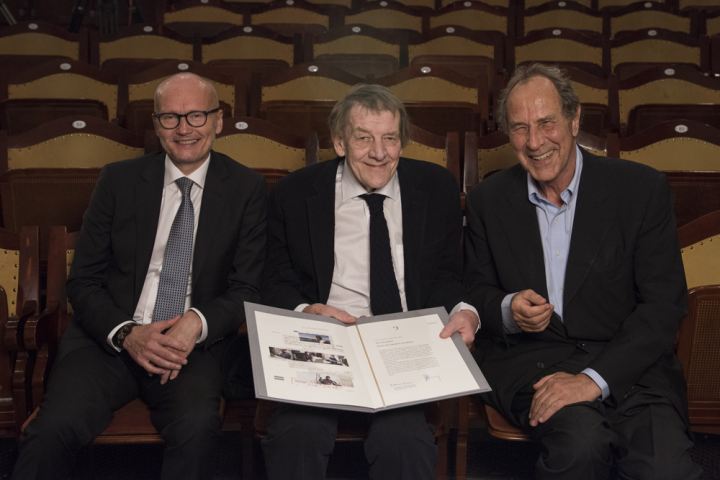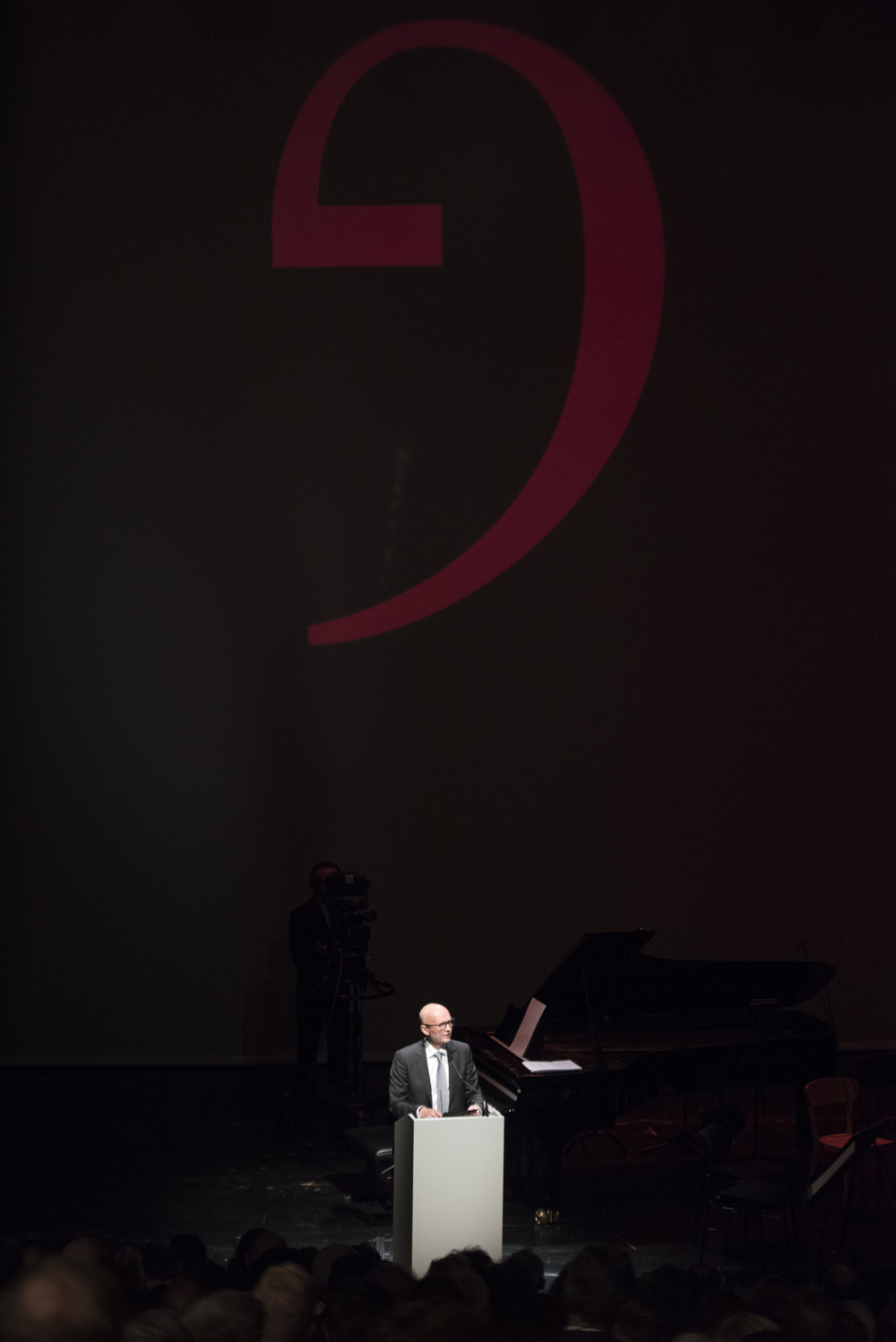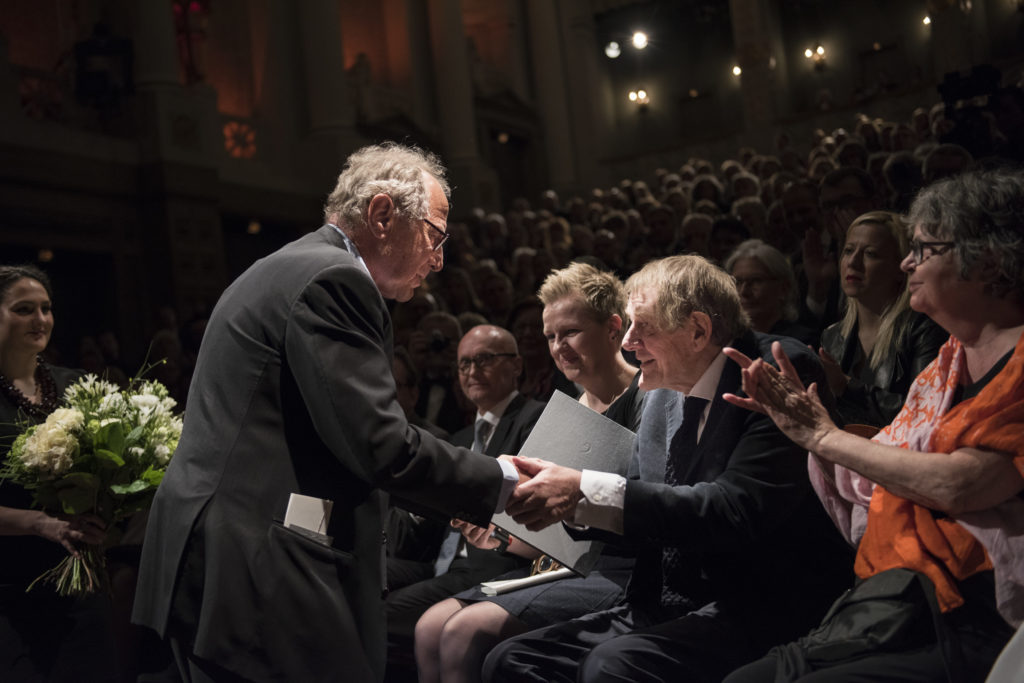Laudatory address to Per Nørgård on 2 May 2016 at the Prince Regent Theatre in Munich on the occasion of the presentation of the Ernst von Siemens Music Prize.

By Anders Beyer
As a teenager, Per Nørgård had already developed a certain artistic credo, which essentially entailed confusing as many people as possible, as much as possible.
This initial conception consequently deepened into a philosophy in which art and the life lived should serve as fieldwork in a gesammtkunstwerk and, for more than six decades he has created chaos, confusion, and of course great portions of delight with his unrestrained expeditions into the world of music.
When the composer uses the word “confusion” it can immediately seem disconcerting. Nørgård has offered a clarification. “I want ambiguity. I use this word in all situations together with the word “Interference”. Interference or ambiguity in its broadest form is my objective.”
This ambiguity means that the listener is never entirely sure what the music is about. And to quote conductor Celibidache: “Only the consciousness of the future in the new millennium will be able to fully understand the powers of Per Nørgård’s music.”
We see ambiguity throughout the Nørgårdian oeuvre, which aesthetically, diverges widely into multi-directional compositional expeditions. Perhaps one can speak of a musical prose without rhythm and without rhyme, but flexible and strong enough to follow the soul’s lyrical movements, the flow of dreams and leaps of consciousness.
What form of linguistic imagery could possibly explain this Nørgårdian universe? The journey as a metaphor can be one possible starting-point when describing Per Nørgård’s art. His music often contains these black holes or vast areas of emptiness, as if we were listening to a void created by a person’s abrupt departure.
Per Nørgård is something of a musical traveller, but not as Schubert, Casper David Friedrich, Wagner or Poe with journeys and expeditions that left them feeling doomed and lacking in certainty. Nørgård’s journeys did not lead to futile discoveries, but were periods for reflection; images and sounds that describe states of being.
An important part of this reflective state is reminiscence, which pops up in the middle of everything as a surprise, but not demonstratively so, subtlety is always nearby. In this way Nørgård’s music acquires not only a certain transience in character, but also futility, a dark wit and defiance, both in relation to existing social reality and to musical logic. The life lived and music are intertwined to create a great tapestry.

I imagine that a good deal of effort is spent on rejecting selections as opposed to adding them. Because, there is in principle room for everything in Per Nørgård’s universe, and viewed from the outside the whole thing strangely enough fits together. Not only can anything happen, everything does in fact happen: Within his works and outside his works, and in the lived life’s wondrous arabesque of happenings.
Per Nørgård’s ability to forget, and his ability to withdraw from himself and from others only adds to the realm of possibilities. How many composers have, for example experienced that their misplaced attaché case with original score is shot full of bullet holes by a police bomb squad robot? Per Nørgård has.
Nørgård’s output shows a willingness to experiment, which has always been an integral part of the composer’s working method. One doesn’t find safety-first solutions with Nørgård; no showing off, no unnecessary displays. In a time where mainstream is the norm and box office results are the measure of quality, Per Nørgård resists the homogenized and the superficial.
So, should every work, whether it succeeds on paper or not, be a physical trial for the composer? The work appears to make him run around in circles until he catches hold of a thread of continuity or, ”bridge” as he calls it, that permits a dialogue with the inner will and force within the material.
As previously implied, the artistic universe and Per Nørgård are interwoven, from the beginning until now, as a great work in progress. This is paradoxical because, over the years the composer has been continuously breaking with his own musical traditions in the name of self-extension: From ironic pastiches, the Infinity Rows, the Golden Section, the beauty-seeking metaphysics of the 70s, through to the 80’s encounter with great existentialistic questions centred around a large group of works, significantly inspired by the schizophrenic artist Adolf Wölfli, to the experiments in the 90’s with phenomena that Nørgård calls “tone lakes” – all these are methods for generating tonal sequences, which can sustain the predominant need for expression.
•
The young Per started to draw and compose music for home-made films in the latter half of the 1940’s. He called these films ‘tecnis’ and they were shown within his immediate family circle. Even then the artist made notes about his creations. He retracted the “works” in the tecnis series, and in the young Per’s catalogue one of the productions was called “Will”, which according to himself is a “top quality film of considerable length with no fewer than two breaks”. This film was show on 9th March 1947. The hero in the film visits several foreign countries to the accompaniment of a distinctive musical score.
The reason why Nørgård started to work with music at all as a teenager was that he dreamt of a music that didn’t exist. He had a vision of a completely different music, a vision that for many years, he bore in secret. In his opinion something was missing in existing music – he believed that there was a need to contribute something to this world that is so full of music.
In the composer’s own words:
“I had a sensation that within music there was an unchartered and thoroughly fantastic potential. Quite early on I had a conception of a quite different music, a music where every single tone was part of many melodies: That all the sounds in a huge endless entity, in some way would create one melody. All the melodies emanated in reality from the same huge torrent that was a kind of illusion of a line, but it was really just a point that showed new facets of itself all the time.
I imagined a music that is woven out of such a tonal point, and in which time seems to constantly change frequency. I didn’t dare to speak of this vision to anyone. And I had in fact dreamt on two separate nights with a year between, a dream that had left me shaken when I woke in the morning. I only knew that something had happened. I was on a high cliff in a house with deep sills, nothing on the walls, white walls, an immense light from the sun and bright blue skies outside. I was alone. There were two rooms and I was in the one that was empty. I went into the other room and there I found a large black grand piano. When I went towards it I knew that this was my destiny.
One can dream about anything, therefore dreams aren’t necessarily predictive, but it was the glow of that dream. It had something to do with the supernatural colours and the light. It had nothing to do with a normal dream. It was like a burning torch. I was 14 years old. The following year the dream came again. Completely unchanged – I’m there in the same room, and walk in, and there is the grand piano. I swear that it was just like a re-run film clip. Not just that the glow was so strong, but to dream the same dream again! So some spirit or other must have convinced me that I was a composer.”
•
When Nørgård was about 17 years old he made a committed decision to follow a musical pathway, and we can trace a distinct line from the first step: The composer has always lived at the edge of turmoil different kinds of turmoil but always turmoil. As soon as he establishes a stylistic platform, he breaks away from it and seeks a new shade of turmoil. This is part of the ambiguity or disconcertion if you will.
Nørgård gained prominence as a sharp critic in newspapers and journals and became both an intellectual mentor and source of inspiration for a younger generation of composers. That Nørgård’s fame reached beyond the confined professional environment was as much the result of his wonderful communication skills as his abilities as a teacher and writer, and this combined with a playful and mischievous sense of humour. One becomes enchanted by both Nørgård the man and Nørgård the artist.

It could be expected that Per Nørgård’s many areas of interest in the world of music would impede his creativity as composer, but that is too hasty a conclusion because they in fact nourish each other. For example, when Nørgård became inspired by the world of fractals and current advances in chaos theory, his interest did not remain merely theoretical. On the contrary, he attempted to inject these ideas into his musical practice – the world of ideas was transferred to the concrete world. The musician’s practical craftsmanship, the theorist’s speculative nature and the artist’s soul-shattering and meticulous submergence are all embodied in Per Nørgård.
Another important word in the Nørgårdian oeuvre is potpourri, which means that part of the music is in reality what Adorno called gesunkenes Kulturgut. But in this instance, potpourri does not mean that one should read Nørgård’s musical landscape à la lettre, because then it would appear as a continuation of old established structures. Instead one should interpret this potpourri as a distinctive signature in each work. His interest in marches, popular music, folklore music and much more should be mentioned here, including all sorts of miscellaneous tomfoolery which contributes to the confusion.
Nørgård has spent a lifetime in perpetual critical dialogue regarding tradition, both relating to the potpourri and to recycling from music history’s great vault. The composer is at best a musical kleptomaniac, or as Stravinsky expressed it: “Lesser artists borrow, great artists steal”.
The journeys to foreign lands and the openness shown to a young music student such as myself, to eccentric souls, to outermost outsiders, to children, to amateurs, to the mentally handicapped, to professionals, and to sudden impulses – the depth of interest shown in people and their lives – has been predominant in Per Nørgård since the top quality film about “Will”.
I hope I may be allowed to conclude with these final descriptive words. If I had only one word with which to describe Nørgård, I would use openness. Openness is closely related to curiosity and together they provide room for enchantment, which allows you to meet that which is strange, with openness.
Per Nørgård is open almost to the point of naivety. If his wife Helle were to tell him that there is a UFO in the yard, Per Nørgård would go out and check. Just to make sure. I remember one New Year’s Eve when we stood on the beach by the composer’s cabin on the island of Langeland and Per Nørgård pointed towards the sky and said (freely cited from memory): ”This is where we saw two moving UFO’s travelling in parallel across the night sky”. And he seemed to believe it.
Dear Per Nørgård. I have had the privilege of charting your artistic journey since 14th August 1985, when you picked up this young student on a country road in your yellow Morris Mascot, and which lead to an acquaintance spanning more than 30 years.
I’ve had the honour of commissioning several works from you over the years; the most recent was for the Bergen International Festival, where the Bergen Philharmonic Orchestra with soloists Peter Herresthal (violin) and Jakob Kullberg (cello) premiered your double concerto, “Three Nocturnal Movements”. Ambiguity was also intact here, you succeeded in perplexing me, but as always, you perplex and create disruptive innovation in an inspiring manner, so that again and again one must revisit the music and experience it from other facets.
Today, you receive one of the greatest and most prestigious prizes in the world of classical music; the Ernst von Siemens Music Prize. I think I may speak both personally, and on behalf of Danish culture when I express immense pride in this recognition of your artistic creation, and your award of this great prize.
Congratulations Per Nørgård!
© Anders Beyer 2016.

